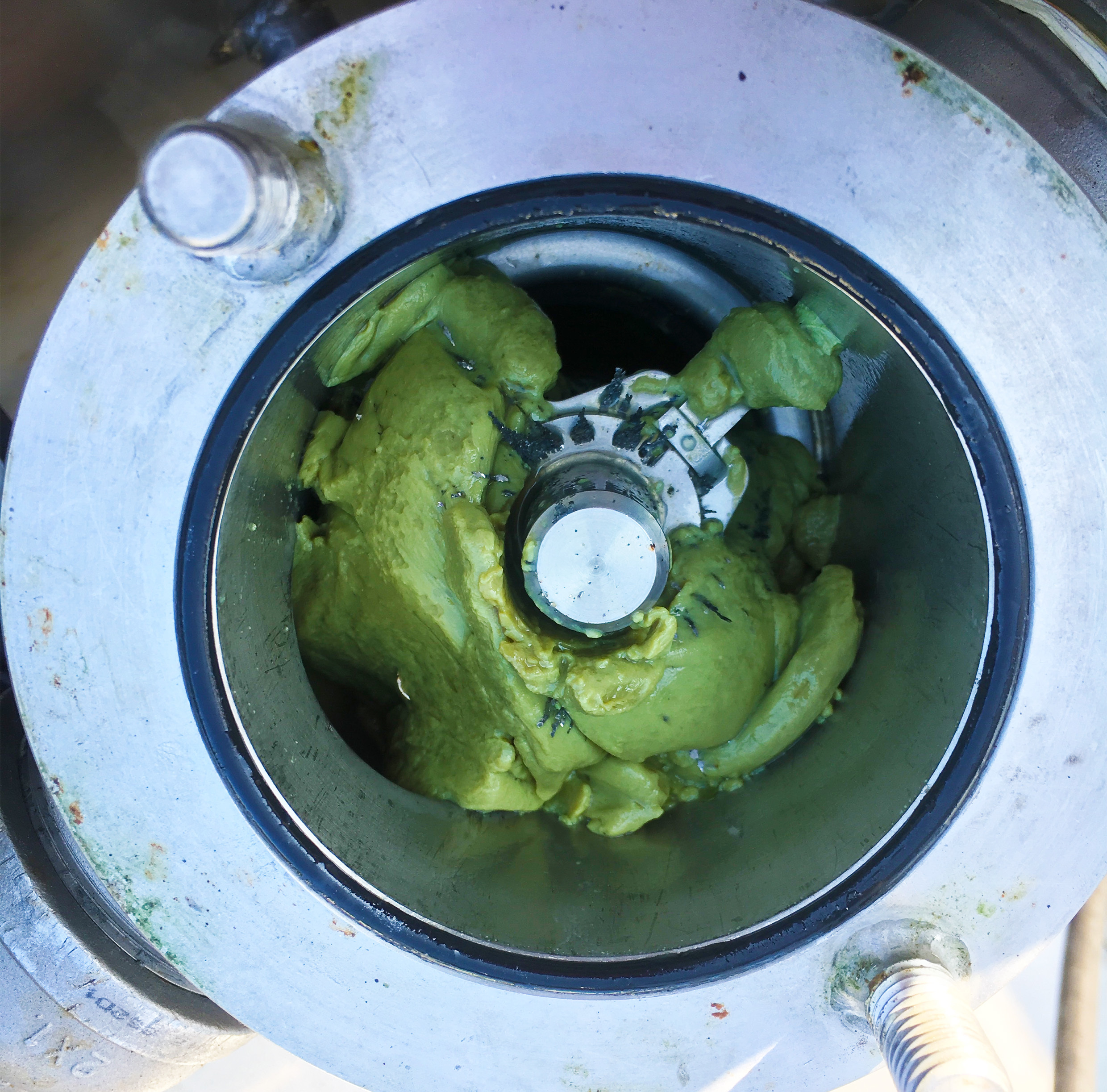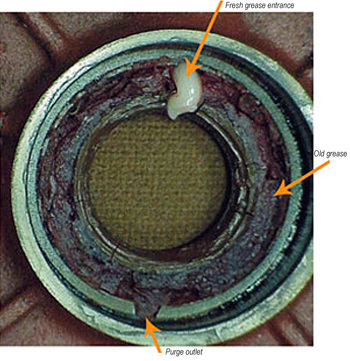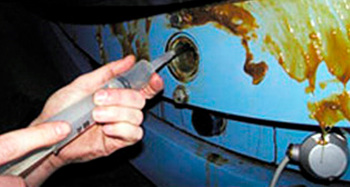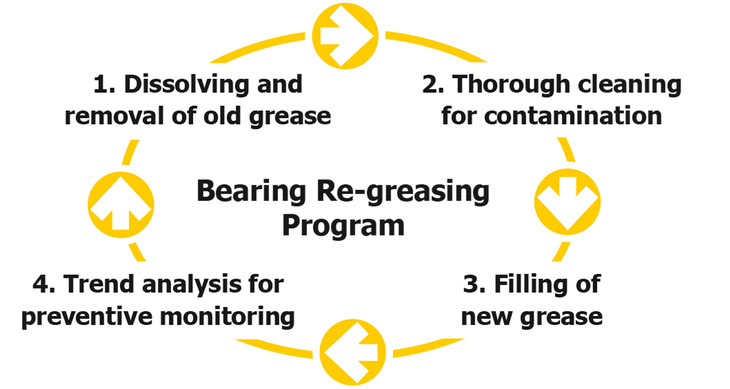A newly patented method developed by IKM Ocean Team results in minimised maintenance costs and increased system reliability.
Over time, grease will loose its lubricity. Grease basic contains two things: a base oil and a thickener.
One cause of decreasing lubricity of grease is that eventually the base oil will sweat out of the thickener, which will harden the thickener that is left back in the bearing. Another reason for decreasing lubricity is solid and liquid contamination. By time, the grease can be contaminated with micro particles e.g., internal metal particles as a result of wear or external particles from the surrounding environment.

IKM Ocean Team works with grease application on various assets.
Facts show that 80% of all breakdowns in bearing systems are caused by grease problems - either because of decreasing lubricity or unsuitable grease. In order to secure a reliable operation of bearings, it is therefore essential to maintain a sufficient and correct lubrication.
Top Causes of Bearing Breakdowns
- 10%: Unsuitable choice of bearing (e.g. design. size and load carrying capacity)
- 5%: Mounting faults (e.g. misalignment)
- 5%: Consequential damage
- 1%: Material and production faults
- 20%: Aged lubricant
- 20%: Solid contamination
- 5%: Liquid contamination
- 20%: Unsuitable lubricant
- 15%: Insufficient lubricant
- = Approx 80% caused by insufficient or wrong lubrication.
Source: Machinery Lubrication, no. 4/2012
Old Grease is Poison to Bearings
Today, we often see people try to solve lubrication problems in their bearing systems simply by adding new grease to the bearing. It is commonly known that fresh grease prolongs bearing life and restores reliability. BUT people often forget to remove the old, hardened and contaminated grease before adding the fresh grease, why the re-greasing would not have the desired effect.
The problem by just adding fresh grease on top of old grease is that the fresh grease will not be able to push around with the old grease because of the higher viscosity of the old grease. The old and hardened grease will then remain stuck in the bearing and force the fresh grease the easiest way out of the system, which often will be through the seals. The old grease is blocking the way for the new and fresh grease and preventing it from spreading properly inside the bearing
When fresh grease is coming out of the bearing seals, people often mistakenly take this as a sign of a successful re-greasing. But actually it is still the old grease, which is lubricating the bearing and therefore you risk considerable damage to you bearing, if you continue operation thinking that you have solved the lubricity problem.

Photo of an over-greased bearing, where the fresh grease has been forced out of the bearing seals
When re-greasing your bearings it is therefore of great importance, that old and hardened grease is removed from the system before new is added.
Known Method to Removal of Old Grease
The normal method to remove old and hardened grease from bearings is manually scraping and/or wiping out the aged grease. This is done by dismantling the bearing, which can cause atmospheric particles from the surrounding environment to enter the bearing system. If the
removal of the aged grease is not followed up by a thorough cleaning, you therefore risk unwanted particles to start an accelerating wear at the bearings. Further disadvantages by dismantling the bearings and removing the old grease manually are that it is a time consuming and labour costly process, why it is normally only done at larger bearings, where the cost of replacing the bearing is high.

Efficient “Bearing Re-greasing Program”
By use of IKM Ocean Team’s patented “In-depth Bearing Degreaser”, we are capable of providing a complete package solution to the market within re-greasing of bearings. The program is suitable for all kinds of medium and large-sized grease lubricated bearings for example placed within wind turbines and other rotating systems.
Our unique system eliminates the need of dismantling the bearings during removal of old grease as well as securing a completely clean bearing before any new grease is added. This makes the solution favourable for situations with bad lubricity of the existing grease or if a conversion to a new grease product is to be conducted.
 The content of IKM Ocean Team’s Bearing Regreasing Program.
The content of IKM Ocean Team’s Bearing Regreasing Program.
- Dissolving and Removal of Old Grease
IKM Ocean Team has developed a newly patented unit, which significantly improves the work process of regreasing, both regarding time-consumption and efficiency. The method is based on a two-step cleaning process.
In the first step a corrosion inhibited dissolving fluid is injected into the bearing system in order to dissolve the old and possible hardened grease. The dissolving fluid is chosen on the basis of the characteristics of the exact grease, which it is to dissolve. We always use a non-water-based dissolving fluid in order to avoid oxidation at the bearing during the cleaning process.
- Thorough Cleaning for Contamination
When the old grease has been dissolved and removed from the bearing, then a flushing fluid is entered to the bearing system with the purpose to flush and filter the bearing for unwanted particles and remains from the old grease.
Ahead of the flushing process, a test of the flushing fluid and the new grease is to be conducted in order to secure that the two products are compatible with each other. The bearing is flushed with turbulent flow conditions in order to secure all impurities are loosened from the inside of the bearing and flushed out and captured by the filter system. During this process, the cleanliness level of the bearing is closely monitored by analysis of the flushing fluid with reference to the ISO 4406 and ISO 4407 classification. The two-step cleaning process is performed by use of only one unit: The In-depth Bearing Degreaser from IKM Ocean Team.
- Filling of new Grease
When an acceptable cleanliness level has been reached, the flushing fluid is drained from the bearing and new, fresh grease is added to the bearing.
- Trend Analysis for Preventive Monitoring
Trend analyses of grease samples have shown that trouble with grease or bearings can be recognized in advance with an efficient grease analysis program. The program enables you to take action before the degradation of the grease becomes urgent and thereby prevent accelerating wear and possible breakdowns of the bearing. The result is extended lifetime of bearing components and minimised production loss. At our laboratory we are able to perform the necessary tests, which will give you a useful overview of the condition of your grease. The test results include information about the amount of wear, contamination consistency, bleeding behaviour and condition of the base oil and additives.
A Faster, Safer and Cost-saving Method
IKM Ocean Team’s “Bearing Re-greasing Program” represents an efficient cleaning and re-greasing solution as well as a preventive monitoring program, which all together ensure the best conditions for your bearings. The result is:
- Extended lifetime of bearings; optimised lubricity of the grease as well as a good cleanliness level reduce wear at system components.
- Minimised risks of breakdowns; thorough removal and cleaning of remains of the old grease as well as other contaminants ensure a more reliable operation. Regularly trend analyses further ensure that you do not operate your bearing systems in blindness.
- Minimised time-consumption; no need of dismantling, which makes the method significantly faster than alternative manual regreasing methods.
- Increased safety; no dismantling of the bearings increases personal safety as to less handling and no direct contact with the grease.
- Minimised maintenance costs; as to reduced wear at bearing components and less personnel costly method.